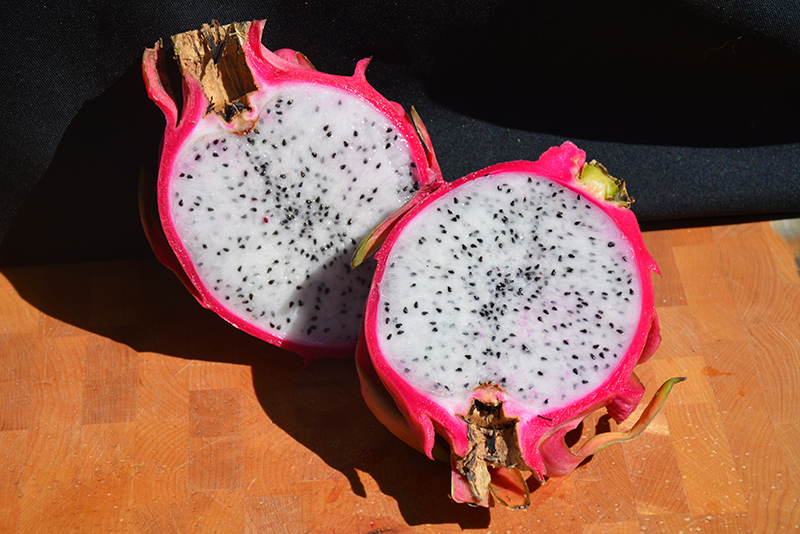Height: 10 feet Spread: 10 feet
Sunlight:
Hardiness Zone: 10a Description: An exotic cactus with creeping, sprawling, or climbing stems that are spiny, and will branch profusely; scented, nocturnal white and yellow flowers appear in summer, followed later by delicious, sweet red fruit; an amazing accent or container plant Ornamental Features Delight Dragon Fruit is an atypical member of the cactus family known as an 'epiphyte' or 'air plant', which means that it doesn't necessarily require a growing medium for its roots. Like all other cacti, it doesn't actually have leaves, but rather modified succulent stems that comprise the bulk of the plant. This particular variety of cactus is valued for its characteristically trailing and weeping form on a plant consisting of long and flattened spiny green segmented stems that form 'branches' which spread out from a central base. This plant features showy fragrant white cup-shaped flowers with yellow eyes and buttery yellow bracts along the stems from early to late summer. The flowers are excellent for cutting. It features an abundance of magnificent red berries with light green tips from mid summer to early fall. The fruit can be messy if allowed to drop on the lawn or walkways, and may require occasional clean-up. This plant is primarily grown as an ornamental, but it's also valued for its edible qualities. The oblong sweet fruit is most often used in the following ways: Landscape Attributes Delight Dragon Fruit is a large succulent evergreen plant with a form that trails along the ground or spills over containers and rock walls. It commonly grows as a shrub-like plant with multiple 'branches' and stems. As a type of cactus, it has no true foliage; the body of the plant is wholly comprised of a linked series of spiny green stem segments which are connected together to form the branches of the plant. This plant will require occasional maintenance and upkeep, and can be pruned at anytime. Stray segments or shoots can be carefully removed or thinned to control the overall form and spread of the plant. Deer don't particularly care for this plant and will usually leave it alone in favor of tastier treats. Gardeners should be aware of the following characteristic(s) that may warrant special consideration; Delight Dragon Fruit is recommended for the following landscape applications; Planting & Growing Delight Dragon Fruit will grow to be about 10 feet tall at maturity, with a spread of 10 feet. It has a low canopy with a typical clearance of 1 foot from the ground. It grows at a medium rate, and under ideal conditions can be expected to live for 60 years or more. This is a self-pollinating variety, so it doesn't require a second plant nearby to set fruit. This plant should only be grown in full sunlight. Unlike most cacti, which are known for their strong preference for hot, dry growing environments, this plant is native to tropical climates and grows in areas with more humidity and rainfall than most cacti. It is very adaptable to both dry and moist growing conditions, but will not tolerate any standing water. It is considered to be drought-tolerant, and thus makes an ideal choice for a low-water garden or xeriscape application. Like most succulents and cacti, this plant prefers to grow in poor soils and should therefore never be fertilized. It is not particular as to soil type or pH. It is somewhat tolerant of urban pollution. This particular variety is an interspecific hybrid. It can be propagated by cuttings; however, as a cultivated variety, be aware that it may be subject to certain restrictions or prohibitions on propagation. Delight Dragon Fruit is a fine choice for the garden, but it is also a good selection for planting in outdoor pots and containers. Because of its trailing habit of growth, it is ideally suited for use as a 'spiller' in the 'spiller-thriller-filler' container combination; plant it near the edges where it can spill gracefully over the pot. It is even sizeable enough that it can be grown alone in a suitable container. Note that when growing plants in outdoor containers and baskets, they may require more frequent waterings than they would in the yard or garden.![]()
![]()
![]()
![]()
![]()
![]()
![]()
![]()
![]()
![]()
![]()
![]()
![]()
![]()
![]()
top of page
Louie's Nursery Menifee - Plant Finder
Characteristics
Applications
Features & Attributes
This tool is an online resource representing many of the varieties that we carry over the course of the season, and is intended for informational purposes only. Inventory varies seasonally, so we cannot guarantee that every plant will be in stock at all times - please contact the store directly for current availability. It does not include our entire selection of plants, so be sure to visit our store to see varieties that may not be represented on this list.
bottom of page
